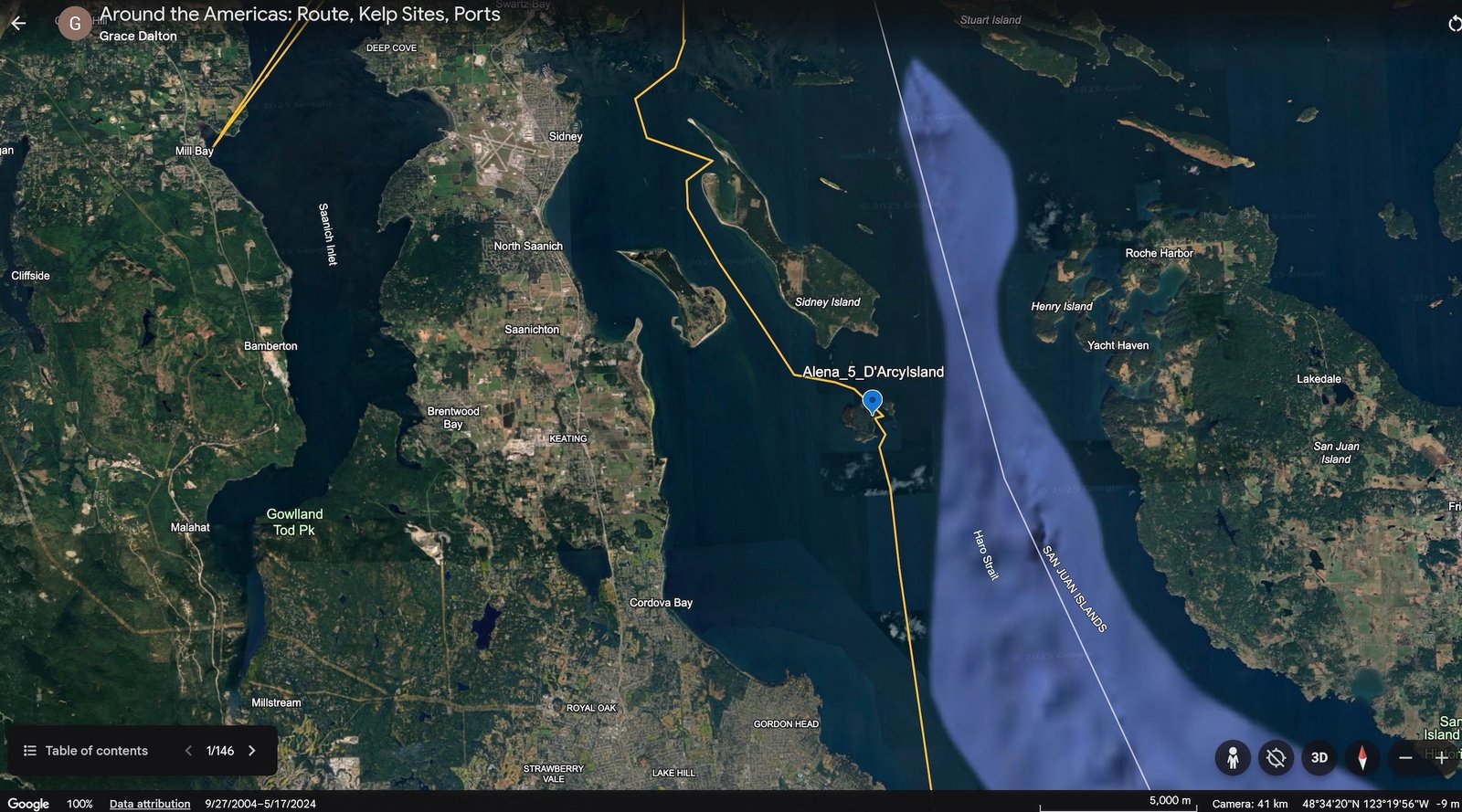Kelp Research
The first latitudinal analysis of floating kelps (Bull and Giant kelp) from Alaska to Patagonia, covering the known regions where they occur with the associated environmental conditions. As part of the 2025-2026 Around the Americas expedition, we will establish kelp sampling stations in Alaska, British Columbia, Washington, Oregon, California, Chile, and Argentina, following the predefined route of ONE OCEAN.
Introduction
Kelp forests are among Earth’s most dynamic and productive marine ecosystems, created by giant kelp (Macrocystis pyrifera) and bull kelp (Nereocystis luetkeana). These underwater forests thrive in temperate coastal waters, offering vital habitat and nourishment for diverse marine life, from microscopic invertebrates to large marine mammals. They are also integral to the marine carbon cycle, boasting primary production rates comparable to those of tropical rainforests. Beyond their ecological importance, kelp forests hold cultural significance for Indigenous communities along the Pacific coast and contribute to commercial industries and scientific research.
However, these ecosystems face mounting challenges due to their sensitivity to environmental changes. Warming ocean temperatures, overfishing, pollution, unsustainable harvesting, nutrient depletion, and overgrazing by sea urchins undermine their health and resilience. The loss of key predators, such as sea otters and sea stars, has further intensified sea urchin overgrazing, while marine heatwaves have accelerated the decline of kelp forests. The degradation of these ecosystems has far-reaching impacts, threatening marine biodiversity and the coastal communities that depend on them.
The Role of Kelp Forests
Kelp forests are vital to the health of marine ecosystems, functioning as underwater nurseries and refuges. The canopy they form supports a wide variety of life, from algae and invertebrates to commercially significant fish species such as rockfish and salmon. These ecosystems stabilize coastal environments by buffering wave energy and reducing erosion. Kelp forests play a pivotal role in the global carbon cycle by absorbing carbon dioxide from the atmosphere and generating oxygen through photosynthesis.
Bull Kelp: A Keystone Species
Bull Kelp (Nereocystis luetkeana) is a vital species of the Northern Pacific ecosystems, capable of growing up to 100 feet in a single season. This annual alga begins its life in late winter, with spores settling on rocky substrates in shallow waters. By summer, it forms dense canopies that provide shade and protection for diverse marine species. Its long stipe extends upward to a buoyant bulb, which supports blades that filter sunlight and promote kelp growth.
Bull kelp’s life cycle aligns with seasonal changes: as winter storms intensify, mature plants are dislodged from the seafloor, decomposing to provide nutrients that sustain coastal food webs. The spores left behind ensure the continuity of the kelp forests, creating a self-sustaining cycle of growth and regeneration.
Threats to Kelp Forests
Both natural and human-induced factors increasingly threaten the survival of kelp forests. Overgrazing by sea urchins is among the most pressing issues, particularly in areas where predator populations, such as sea otters, have declined. Pollution from agricultural runoff and urban development can also degrade water quality, inhibiting kelp growth. Climate change amplifies these challenges by increasing ocean temperatures and the frequency of extreme weather events, such as marine heatwaves and intense storms.
In many regions, kelp forest loss has cascading effects on marine biodiversity and coastal economies. The transformation of kelp forests into barren seafloors disrupts food webs, reduces fisheries productivity, and diminishes the coastal protection these ecosystems provide.
Monitoring and Conservation
Advances in satellite technology have revolutionized the monitoring of kelp forests. Platforms like Landsat allow researchers to track the distribution and health of kelp canopies over time. These tools enable the study of long-term trends and the identification of stressors impacting kelp ecosystems. By integrating satellite imagery with field research, scientists can better predict and respond to changes in these vital habitats.
Conservation strategies focus on reducing localized threats, such as pollution and overgrazing, while addressing broader challenges like climate change. Efforts to restore predator populations, manage sea urchins, and reduce greenhouse gas emissions are critical to the recovery and resilience of kelp forests. Sustainable harvesting practices and public awareness campaigns also play essential roles in preserving these underwater forests for future generations.
Our Research
Kelp forests, formed by giant kelp (Macrocystis pyrifera) and bull kelp (Nereocystis luetkeana), are the foundation of some of the world’s most productive and diverse marine ecosystems. Our research aims to address these challenges by conducting the first comprehensive study of floating kelp forests along the Pacific coast from Alaska to Patagonia. This work will be done by the 2025 - 2026 Around the Americas Expedition, during which we will investigate the distribution, health, and environmental conditions affecting kelp ecosystems in regions where they are known to thrive.
Kelp sites will be established in Alaska, British Columbia, Washington, Oregon, California, Chile, Peru, and Argentina, following the predefined route of the Around the Americas project. This study is a collaborative effort with the University of Victoria, the University of California, Los Angeles, and the Woods Hole Oceanographic Institution.
At each kelp site, we will use drones to capture high-resolution imagery of floating kelp forests. This imagery will allow us to measure the size of the kelp canopy, assess its health, and validate satellite data used for large-scale mapping. Physical measurements, including sea surface temperature and water column properties, will be collected to understand how temperature, salinity, and ocean stratification influence kelp growth. Advanced tools like thermal infrared sensors and CTD profiles will help us analyze the local environmental conditions in detail.
In addition to drone and physical measurements, we will deploy remotely operated vehicles (ROVs) and underwater cameras to explore the depths of kelp forests. These surveys will document the seafloor's structure and the presence of species like sea urchins and sea stars, which play critical roles in kelp forest dynamics. Combining this localized data with high-resolution satellite imagery from platforms such as Sentinel-2 and PlanetScope can create a comprehensive picture of kelp forest health and distribution across the Pacific coast.
Our study will also explore the potential of hyperspectral satellite imagery to analyze kelp traits at large scales despite their lower spatial resolution. By integrating this advanced technology with traditional methods, we aim to better understand the impacts of climate change and other stressors on kelp ecosystems.
This research will provide valuable insights into the state of kelp forests and the factors driving their decline. By improving our understanding of these vital ecosystems, we hope to contribute to their conservation, restoration, and resilience in the face of a rapidly changing world.




